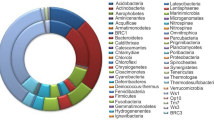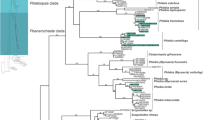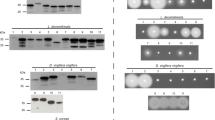Abstract
Cellulose is the most abundant polymer in the world and termites are the most important metazoan cellulose processors. Termites are divided into lower and higher termites, with the latter being the most derived and most specious. Although termites are known for their ability to digest wood, members of the family Termitidae (higher termites) are nutritionally diverse in their use of cellulose. This study investigated the evolution of endogenous cellulases in 25 species of higher termites, using phylogenetic inferences from mitochondrial (16S) and nuclear (28S) ribosomal RNA and endo-β-1,4-glucanase sequences. The translated endo-β-1,4-glucanase amino acid order in all 41 sequences obtained showed high similarity to endo-β-1,4-glucanases in the glycosyl hydrolase family 9. The inferred endo-β-1,4-glucanase phylogenetic tree showed congruency with the mitochondrial/nuclear tree, with the fungus-growers being the most basal group and the soil/litter- and wood/lichen/grass/litter-feeders being the most distal diphyletic feeding groups. The bacterial comb-grower formed a separate clade from the fungus-growers and is sister groups with the soil/litter- and wood/lichen/grass/litter-feeders. There was also a strong diphyletic relationship between endo-β-1,4-glucanases of upper layer soil-feeders and the other soil-feeders. Within the monophyletic wood/lichen/grass/litter-feeding termites’ subclade, the nasutitermitines were polyphyletic and a strong diphyletic relationship was observed in the most distal lichen- and the grass/litter-feeders groups.


Similar content being viewed by others
References
Arshad M.A., Schnitzer M. and Preston C. 1987. Characteristics of a termite fungus comb studied by chemical and spectroscopic methods. Soil Biol. Biochem. 19: 227-230
Brauman A., Bignell D.E. and Tayasu I. 2000. Soil-feeding termites: Biology, microbial associations and digestive mechanisms. In: Termites: Evolution, Sociality, Symbioses, Ecology (T. Abe, D.E. Bignell and M. Higashi, Eds). Kluwer Academic Publisher, Dordrecht, The Netherlands. pp 233-259
Bujang N.S., Harrison N.A. and Su N.-Y. 2011. An improved method for extraction and purification of termite endo-β-1,4-glucanase from FTA® cards. Fla. Entomol. 94: 356-358
Darlington J.P.E.C. 1994. Nutrition and evolution in fungus-growing termites. In: Nourishment and Evolution in Insect Societies (J.H. Hunt and C.A. Nalepa, Eds). Westview Press, Boulder, Colorado. pp 105-130
Davison A. and Blaxter M. 2005. Ancient origin of Glycosyl Hydrolase Family 9 cellulase genes. Mol. Biol. Evol. 22: 1273-1284
Donovan S.E., Eggleton P. and Bignell D.E. 2001. Gut content analysis and a new feeding group classification of termites. Ecol. Entomol. 26: 356-366
Eggleton P. and Bignell D.E. 1995. Monitoring the response of tropical insects to changes in the environment. In: Insects in a Changing Environment (R. Harrington and N.E. Stork, Eds) Academic Press, London. pp 473-497
Eggleton P., Bignell D.E., Sands W.A., Waite B., Wood T.G. and Lawton J.H. 1995. The species richness of termites (Isoptera) under differing levels of forest disturbance in the Mbalmayo Forest Reserve, southern Cameroon. J. Trop. Ecol. 11: 85-98
Engel M.S. and Krishna K. 2004. Family-group names for termites (Isoptera). Am. Mus. Novit. 3432: 1-9
Engel M.S., Grimaldi D.A. and Krishna K. 2009. Termites (Isoptera): Their phylogeny, classification, and rise to ecological dominance. Am. Mus. Novit. 3650: 1-27
Garnier-Sillam E., Toutain F., Villemin G. and Renoux J. 1989. Études préliminaires des meules originales du termite xylophage Sphaerotermes sphaerothorax (Sjostedt). Insect. Soc. 36: 293-312
Grassé P.P. 1978. Physiologie des insectes. Sur la véritable nature et le rôle des meules à champignons construites par les termites Macrotermitinae (Isoptera: Termitidae). C.R. Acad. Sci. Paris. 287: 1223-1226
Heim R. 1977. Termites et Champignons. Boubée, Paris.
Innis M.A. and Gelfand D.H. 1990. Optimization of PCRs. In: PCR Protocols: A Guide to Methods and Applications (M.A. Innis, D.H. Gelfand, J.J. Sninsky and T.J. White, Eds). Academic Press, San Diego, CA, USA. pp 3-12
Inward D., Vogler A.P. and Eggleton P. 2007. A comprehensive phylogenetic analysis of termites (Isoptera) illuminates key aspects of their evolutionary biology. Mol. Phylogenet. Evol. 44: 953-967
Ji R. and Brune A. 2001. Transformation and mineralization of 14C-labeled cellulose, peptidoglycan, and protein by the soil-feeding termite Cubitermes orthognathus. Biol. Fertil. Soils. 33: 166-174
Khademi S., Guarino L.A., Watanabe H., Tokuda G. and Meyer E.F. 2002. Structure of an endoglucanase from termite, Nasutitermes takasagoensis. Acta Cryst. D58: 653-659
Kovoor J. 1970. Presence d’enzymes cellulolytiques dans l’intestin d’un termite supérieur, Microcerotermes edentatus (Was.). Ann. Sci. Nat. Zool. Biol. Anim. 12: 65-71
Legendre F., Whiting M.F. and Bordereau C. 2008. The phylogeny of termites (Dictyoptera: Isoptera) based on mitochondrial and nuclear markers: implications for the evolution of the worker and pseudergate castes, and foraging behaviors. Mol. Phylogenet. Evol. 48: 615-627
Li Z.-Q, Liu B.-R., Zeng W.-H., Xiao W.-L., Li Q.-J. and Zhong J.-H. 2013. Character of cellulase activity in the guts of flagellate-free termites with different feeding habits. J. Insect Sci. 13: 37
Lo N., Watanabe H. and Sugimura M. 2003. Evidence for the presence of a cellulase gene in the last common ancestor of bilaterian animals. Proc. R. Soc. Lond. B. 270: S69-S72
Lo N., Tokuda G. and Watanabe H. 2011. Evolution and function of endogenous termite celulases. In: Biology of Termites: A Modern Synthesis (D.E. Bignell, Y. Roisin and N. Lo, Eds). Springer, New York. pp 51-67
Marini M. and Mantovani B. 2002. Molecular relationships among European samples of Reticulitermes (Isoptera, Rhinotermitidae). Mol. Phylogenet. Evol. 22: 454-459
Nakashima K., Watanabe H., Saitoh H., Tokuda G. and Azuma J.-I. 2002. Dual cellulose-digesting system of the wood-feeding termite, Coptotermes formosanus Shiraki. Insect Biochem. Mol. Biol. 32: 777-784
Ni J., Takehara M. and Watanabe H. 2010. Identification of activity related amino acid mutations of a GH9 termite cellulase. Bioresource Technol. 101: 6438-6443
Noirot C. 1992. From wood- to humus-feeding: an important trend in termite evolution. In: Biology and Evolution of Social Insects (J. Billen, Ed). Leuven University Press, Leuven. pp 107-119
Ohkuma M. 2003. Termite symbiotic systems: efficient bio-recycling of lignocellulose. Appl. Microbiol. Biotechnol. 61: 1-9
Posada D. and Crandall K.A. 1998. Modeltest: testing the model of DNA substitution. Bioinformatics 14: 817-818
Robson L.M. and Chambliss G.H. 1989. Cellulases of bacterial origin. Enzyme Microb. Tech. 11: 626-644
Ronquist F. and Huelsenbeck J.P. 2003. MrBayes 3: Bayesian phylogenetic inference under mixed models. Bioinformatics 19: 1572-1574
Rouland-Lefevre C. and Bignell D.E. 2001. Cultivation of symbiotic fungi by termites of the subfamily Macrotermitinae. In: Symbiosis: Mechanisms and Model Systems (J. Seckbach, Ed). Kluwer Academic Publisher, Dordrecht, The Netherlands. pp 731-756
Sakon J., Irwin D., Wilson D.B. and Karplus P.A. 1997. Structure and mechanism of endo/exocellulase E4 from Thermomonospora fusca. Nat. Struct. Biol. 4: 810-818
Sands W.A. 1956. Some factors affecting the survival of Odontotermes badius. Insect. Soc. 3: 531-536
Sands W.A. 1969. The association of termites and fungi. In: Biology of Termites, Volume I (K. Krishna and F.M. Weesner, Eds). Academic Press, New York. pp 495-524
Simon C., Frati F., Beckenbach A., Crespi B., Liu H. and Flook P. 1994. Evolution, weighting and phylogenetic utility of mitochondrial gene sequences and a compilation of conserved polymerase chain reaction primers. Ann. Entomol. Soc. Am. 87: 651-701
Slaytor M. 1992. Cellulase digestion in termites and cockroaches; do symbionts play a role? Comp. Biochem. Physiol. 103: 775-784
Slaytor M., Veivers P.C. and Lo N. 1997. Aerobic and anaerobic metabolism in the higher termite Nasutitermes walkeri (Hill). Insect Biochem. Mol. Biol. 27: 291-303
Swofford D.L. 2002. PAUP*. Phylogenetic Analysis Using Parsimony (*and other Methods). Sinauer Associates, Sunderland, MA.
Tamura K., Dudley J., Nei M. and Kumar S. 2007. MEGA4: Molecular Evolutionary Genetics Analysis (MEGA) software version 4.0. Mol. Biol. Evol. 24: 1596-1599
Tokuda G., Lo N., Watanabe H., Slaytor M., Matsumoto T. and Noda H. 1999. Metazoan cellulase genes from termites: intron/exon structures and sites of expression. Biochim. Biophys. Acta 1447: 146-159
Tokuda G., Lo N., Watanabe H., Arakawa G., Matsumoto T. and Noda H. 2004. Major alteration of the expression site of endogenous cellulases in members of an apical termite lineage. Mol. Ecol. 13: 3219-3228
Tokuda G., Lo N., Watanabe H., Hojo M., Fujita A., Makiya H., Miyagi M., Arakawa G. and Arioka M. 2012. Cellulolytic environment in the midgut of the wood-feeding higher termite Nasutitermes takasagoensis. J. Insect Physiol. 58: 147-154
Tomme P.R., Warren A.J. and Gilkes N.R. 1995. Cellulose hydrolysis by bacteria and fungi. Adv. Microb. Physiol. 37: 1-81
Watanabe H. and Tokuda G. 2001. Animal cellulases. Cell. Mol. Life Sci. 58: 1167-1178
Ware J.L., Grimaldi D.A. and Engel M.S. 2010. The effects of fossil placement and calibration on divergence times and rates: An example from the termites (Insecta: Isoptera). Arthropod Struct. Dev. 39: 204-219
Willis J.D., Oppert C. and Jurat-Fuentes J.L. 2010. Methods for discovery and characterization of cellulolytic enzymes from insects. Insect Sci. 17: 184-198
Ye W., Lee C.-Y, Scheffrahn R.H., Aleong J.M., Su N.-Y., Bennett G.W. and Scharf M.E. 2004. Phylogenetic relationships of nearctic Reticulitermes species (Isoptera: Rhinotermitidae) with particular reference to Reticulitermes arenincola Goellner. Mol. Phylogenet. Evol. 30: 815-822
Zhang M., Gaschen B., Blay W., Foley B., Haigwood N., Kuiken C. and Korber B. 2004. Tracking global patterns of N-linked glycosylation site variation in highly variable viral glycoproteins: HIV, SIV, and HCV envelopes and influenza hemagglutinin. Glycobiology 14: 1229-1246
Zhou X., Smith J.A., Oi F.M., Koehler P.G., Bennett G.W. and Scharf M.E. 2007. Correlation of cellulase gene expression and cellulolytic activity throughout the gut of the termite Reticulitermes flavipes. Gene 395: 29-39
Acknowledgments
The authors thank R. Scheffrahn (University of Florida), C.Y. Lee (Universiti Sains Malaysia), A. Robert (Institut De Recherche Pour Le Développement), N. Kanzaki (Forestry and Forest Products Research Institute) and H.F. Li for providing us with the termite samples. We also thank R. Giblin-Davis and R. Scheffrahn (University of Florida) for the critical review of this manuscript. This study was supported in part by a grant from USDA-ARS under the grant agreement No. 58-6435-8-276.
Author information
Authors and Affiliations
Corresponding author
Electronic supplementary material
Below is the link to the electronic supplementary material.
Rights and permissions
About this article
Cite this article
Bujang, N.S., Harrison, N.A. & Su, NY. A phylogenetic study of endo-beta-1,4-glucanase in higher termites. Insect. Soc. 61, 29–40 (2014). https://doi.org/10.1007/s00040-013-0321-7
Received:
Revised:
Accepted:
Published:
Issue Date:
DOI: https://doi.org/10.1007/s00040-013-0321-7




